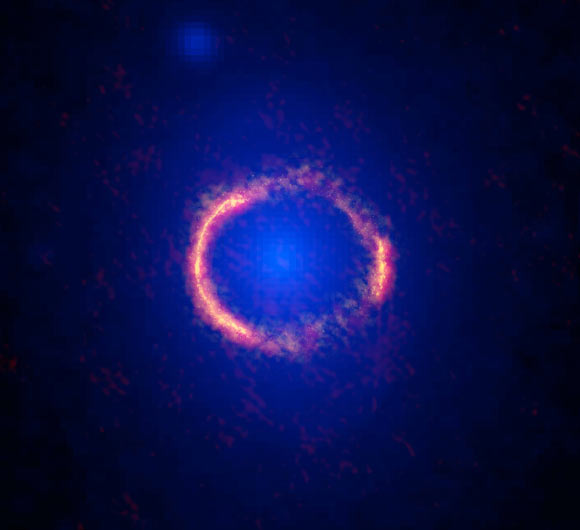Astronomers using the Atacama Large Millimeter/submillimeter Array (ALMA) have captured stunning images of a gravitationally lensed galaxy called HATLAS J090311.6+003906 (SDP.81 for short).

This composite image shows the gravitationally lensed galaxy SDP.81; the bright orange central region of the ring reveals the glowing dust in this distant galaxy; the surrounding lower-resolution portions of the ring trace the millimeter wavelength light emitted by carbon monoxide; the diffuse blue element at the center of the ring is from the intervening lensing galaxy. Image credit: ALMA / NRAO / ESO / NAOJ / B. Saxton / AUI / NSF / NASA / ESA / Hubble / T. Hunter.
Discovered in 2010 by the Herschel Space Observatory, SDP.81 is an active star-forming galaxy approximately 12 billion light-years away from Earth.
It is being lensed by a massive foreground galaxy that is a comparatively nearby – 4 billion light-years away.
The new images of SDP.81 were taken in October 2014 as part of ALMA’s Long Baseline Campaign.
The highest resolution image of the galaxy was made by observing the relatively bright light emitted by the galaxy’s cosmic dust. This striking image reveals well-defined arcs in a pattern that hints at a more complete, nearly contiguous ring structure.
The ring-like structure, called the Einstein Ring, is a rare and peculiar manifestation of gravitational lensing as predicted by Albert Einstein in his theory of general relativity.
Other slightly lower-resolution images, made by observing the faint molecular signatures of carbon monoxide and water, help complete the picture and provide important details about this distant galaxy.
“The exquisite amount of information contained in the ALMA images is incredibly important for our understanding of galaxies in the early Universe,” said Dr Jacqueline Hodge of the National Radio Astronomy Observatory, a co-author of the study accepted for publication in the Astrophysical Journal Letters (arXiv.org preprint).
“Astronomers use sophisticated computer programs to reconstruct lensed galaxies’ true appearance.”
“This unraveling of the bending of light done by the gravitational lens will allow us to study the actual shape and internal motion of SDP.81 much more clearly than has been possible until now.”
For these observations, ALMA achieved an astounding maximum resolution of 23 milliarcseconds, which is about the same as seeing the rim of a basketball hoop atop the Eiffel Tower from the observing deck of the Empire State Building.
_____
C. Vlahakis et al. 2015. ALMA Long Baseline Observations of the Strongly Lensed Submillimeter Galaxy HATLAS J090311.6+003906 at z=3.042. ApJL, accepted for publication; arXiv: 1503.02652







